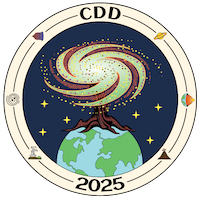The Laser Interferometer Space Antenna (LISA) space based gravitational wave detector is set to be launched in the mid 2035's to be placed 66 000 000 km away from Earth and act as a low frequency GW observatory in space.
LISA will measure gravitational waves in the low frequency regime, ripples in the fabric of space time that are caused by the acceleration of massive objects in space and...
Since its discovery in 1965, the cosmic microwave background (CMB) has been a cornerstone of our standard big bang cosmological model. Space- and ground-based experiments have precisely measured the CMB’s intensity fluctuations across the sky and are improving measurements of its polarization. A current science objective is to search for the signature of an inflationary period that is thought...
A couple of classes of astrophysical objects such as young massive stellar clusters (YMSCs) have recently emerged as promising galactic PeVatron candidates, potentially explaining the knee of the cosmic-ray spectrum as alternative to isolated supernova remnants (SNRs). Meanwhile, the LHAASO observatory is the first to effectively probe the photon detection band above 0.1 PeV, that can...
The InterGalactic Magnetic Field (IGMF) is believed to be a remnant of the Big Bang and the origin of cosmological magnetic fields. However, it has yet to be detected. In this context, the Cherenkov Telescope Array Observatory (CTAO) will have the potential to place competitive constraints on the IGMF by analyzing data from Active Galactic Nuclei (AGN) and Gamma-Ray Bursts (GRBs). In this...
ADAPT [Accelerate Discoveries (boosting) Astroparticle Physics (analysis) Techniques] is the intent to apply machine learning algorithms onto event data from astroparticle physics experiments, to offer an alternative and faster analysis procedure, compared to the computational intense and lengthy classical state-of-the-art algorithms.
The main focus of the project lies in the possibility to...
We compute by means of post-Newtonian (PN) methods the innermost stable circular orbit of comparable-mass compact binaries. Two methods are used with equivalent results: equations of motion in harmonic coordinates and Hamiltonian formalism in ADM coordinates.
The solar convective envelope generates, by dynamo effect, a surface magnetic field whose strength evolves on an 11-year cycle, with a change in polarity at the end of each cycle. A similar magnetic variability exists in other solar-type stars, influencing their dynamics. Furthermore, solar-like oscillators experience acoustic modes whose properties, such as their frequency, amplitude and...
The study of the atmosphere of exoplanets orbiting white dwarfs is a largely unexplored field. With WD 0806-661 b, we present the first deep dive into the atmospheric physics and chemistry of a cold exoplanet around a white dwarf. We observed WD 0806-661 b using JWST's Mid-InfraRed Instrument Low-Resolution Spectrometer, covering the wavelength range from 5 to 12 μm, and the Imager, providing...
The study of X-ray and extreme ultraviolet (together, XUV) emission from stars is recently experiencing a renewed interest in the fields of star-planet interactions and habitability. The presence of an atmosphere is usually considered a requirement for habitability and XUV fluxes are a main concern when trying to establish whether a planetary atmosphere will fade away with time. Particular...
The Euclid spacecraft was launched in July 2023 to the Earth-Sun Lagrange point L2. The mission will produce one of the largest galaxy cluster catalogues withtens of thousands of clusters over the 15 000 square degrees of its extragalactic sky survey. This catalogue will need to be validated with external data, in order to check for newly discovered clusters, to prepare analyses of cluster...

